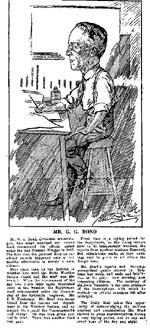


George Grant Bond
Foreword
Introduction
Chapter 1
Chapter 2
Chapter 3
Chapter 4
Chapter 5
Chapter 6
Chapter 7
Chapter 8
Chapter 9
Chapter 10
Conclusion
Register of Marks
Bibliography
References
Index
Search
Help
Contact us

In March of the following year, the department store, Finneys of Queen Street, approached the Weather Bureau for a similar display of flags on their high central tower. They issued brochures, with the flags and their meanings illustrated, plus a little advertising:
Whether it's wet or whether it's fine,
Whether it's hot or whether it's cold,
You can't beat Finneys.
Barry and Robert's Store at the top end of Queen Street, placed the daily forecast in their window and announced that 'Some good friends down the street, intend to supplement our daily forecast by flying of flags from the roof tops. What with their flags and our low prices. Queens Street will be more irresistible than ever'. Finneys replied by stating: 'We call it magnamosity of the highest degree, when the small dog that starts the hare congratulates the big dog on catching it. The weather signal honour has been thrust on us by the Commonwealth Meteorologist who paid us a personal visit. He told us we had the finest building and the most conspicuous flag staff. He said a heap more nice things, which summing up means, "You can't beat Finneys" '.[6]
The Queensland Weather Bureau, by 1912, was functioning with a small staff of five, cramped working conditions and a lack of adequate reporting stations throughout the State. The Brisbane Daily Standard in November 1912, registered complaints by George Bond to the effect that more outside reporting stations were needed, and that the reports received, mostly from Post Masters, contained only the barest information. The approach of the cyclone season called for great teamwork from the scattered band sending reports to the Bureau. Accurate readings were vital in tracking the paths of the fierce storms, and an apparent sudden change of direction, left the weatherman with the doubt of an error, and he had to try to obtain further confirmation before issuing a changed warning. All-night vigils by his telephone, when cyclones were threatening, were a common occurrence for George Bond, and the stress connected with it, and his total involvement, took its toll in the years ahead.
Following an experiment overseas, the first upper air balloon in Australia was released by Mr Hunt in Melbourne on 25th April 1913, followed by the first Brisbane trial on 22nd August from the Worker Building in Elizabeth Street. Mr Fowles, the assistant Meteorologist in Melbourne, and George Bond directed the experiment. Conditions were not ideal, but it was expected that the balloon would be carried seaward on the westerly wind, and then, as it gained height, float back inland. The hydrogen balloon was filled to a circumference of three and a half feet, and had a 'spider frame' attached, on which were mounted the recording instruments. The Brisbane test proved unsuccessful, and the balloon was not recovered.

People in Bright Sparcs - Bond, George Grant; Hunt, Henry Ambrose
 |
Bureau of Meteorology |  |
© Online Edition Australian Science and Technology Heritage Centre and Bureau of Meteorology 2001
Published by Australian Science and Technology Heritage Centre, using the Web Academic Resource Publisher
http://www.austehc.unimelb.edu.au/fam/0148.html